Effects of Technology on Education: Research, Findings, and Future
VerifiedAdded on 2023/01/13
|25
|7068
|72
Report
AI Summary
This research report investigates the effects of technology on education, focusing on its current and future impact. The introduction highlights the significant role of information technology in education, emphasizing its ability to connect students and enhance learning. The literature review examines the types of technologies used, such as electronic whiteboards, desktops, laptops, and projectors, along with their advantages and disadvantages. It also explores the influence of technology on the education sector, including its positive effects on student learning and teaching methods, as well as potential negative impacts like reduced creativity and reliance on the internet. The research methodology outlines a positivism paradigm and a quantitative approach. The report concludes with reflections and future research directions, providing a comprehensive overview of technology's evolving role in education. The report also includes a research ethics form.
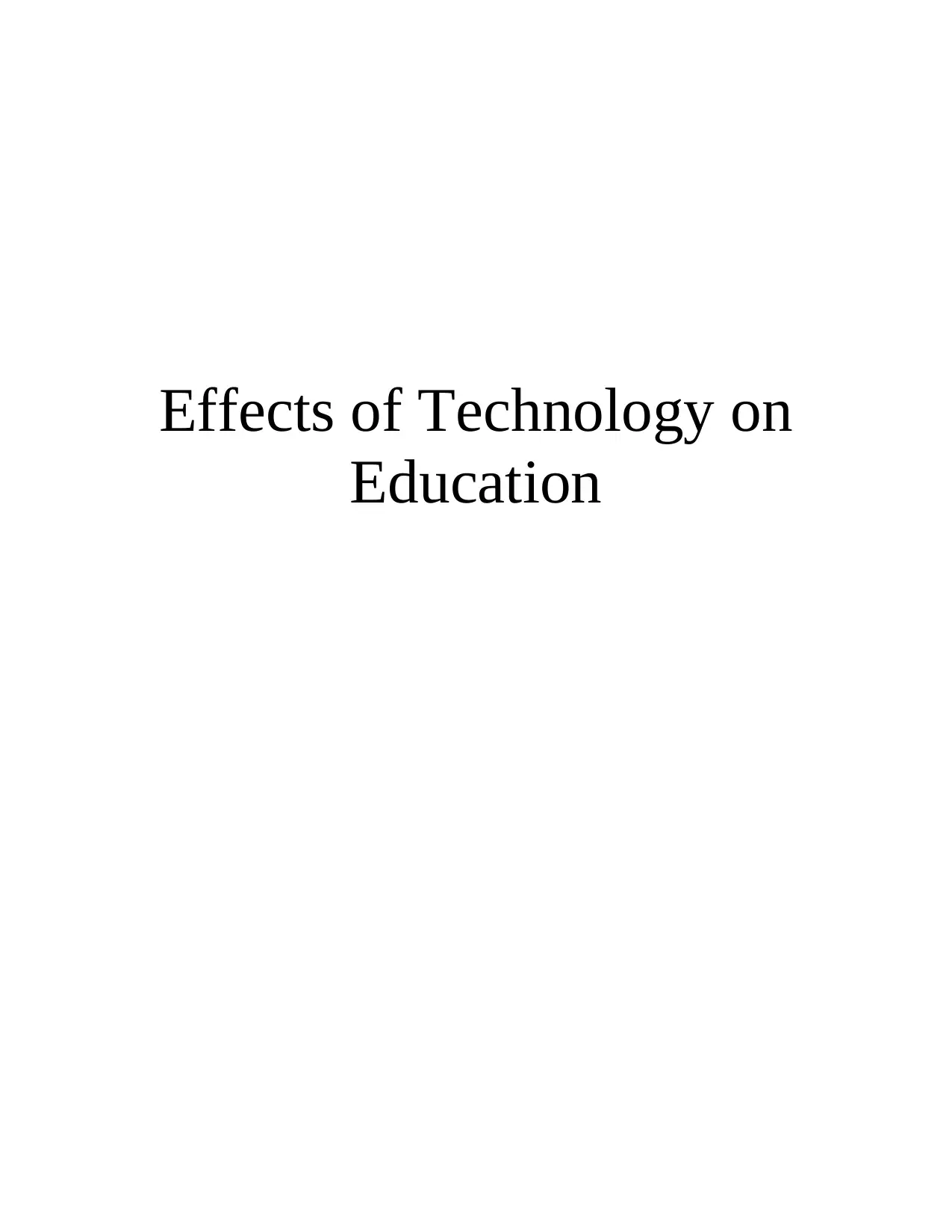
Effects of Technology on
Education
Education
Paraphrase This Document
Need a fresh take? Get an instant paraphrase of this document with our AI Paraphraser
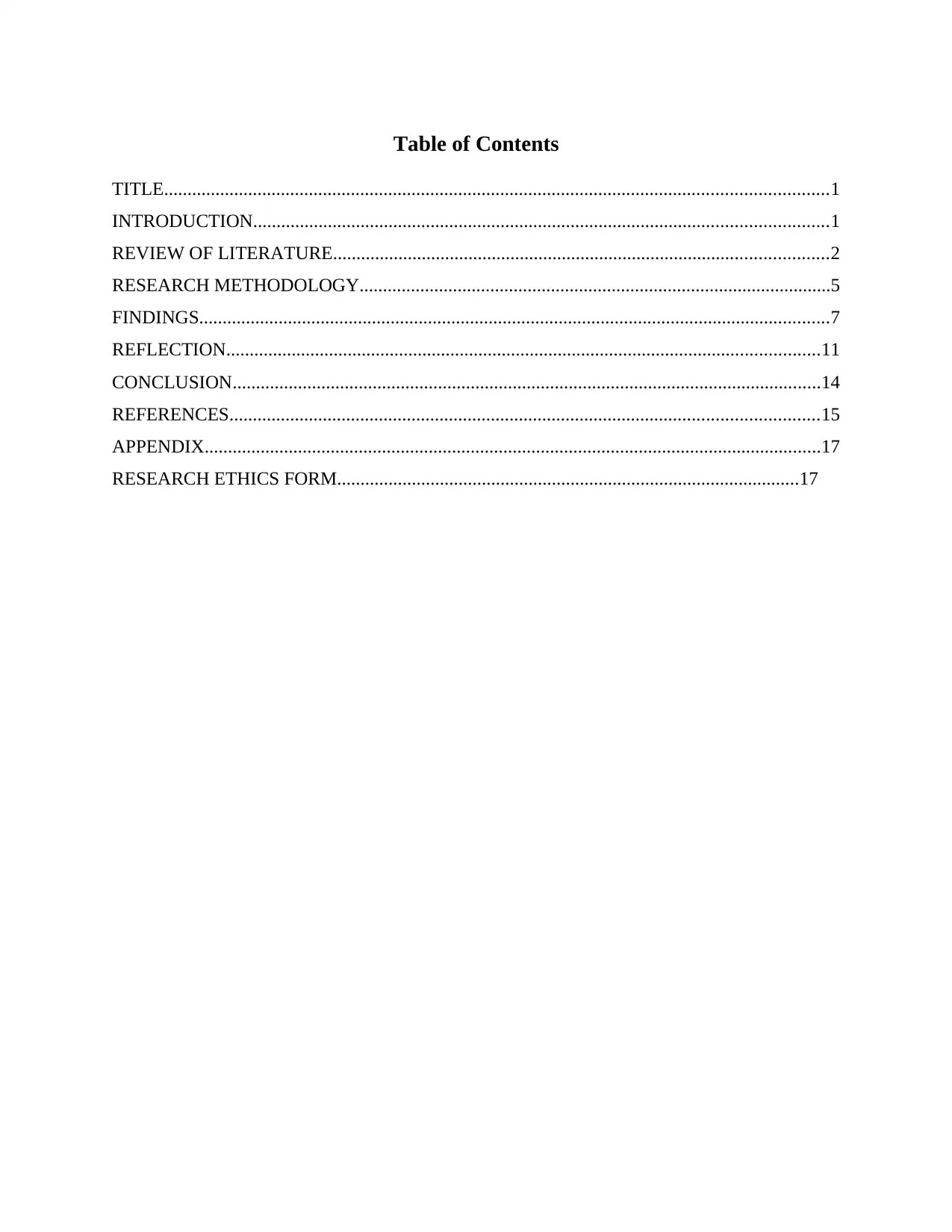
Table of Contents
TITLE..............................................................................................................................................1
INTRODUCTION...........................................................................................................................1
REVIEW OF LITERATURE..........................................................................................................2
RESEARCH METHODOLOGY.....................................................................................................5
FINDINGS.......................................................................................................................................7
REFLECTION...............................................................................................................................11
CONCLUSION..............................................................................................................................14
REFERENCES..............................................................................................................................15
APPENDIX....................................................................................................................................17
RESEARCH ETHICS FORM...................................................................................................17
TITLE..............................................................................................................................................1
INTRODUCTION...........................................................................................................................1
REVIEW OF LITERATURE..........................................................................................................2
RESEARCH METHODOLOGY.....................................................................................................5
FINDINGS.......................................................................................................................................7
REFLECTION...............................................................................................................................11
CONCLUSION..............................................................................................................................14
REFERENCES..............................................................................................................................15
APPENDIX....................................................................................................................................17
RESEARCH ETHICS FORM...................................................................................................17

⊘ This is a preview!⊘
Do you want full access?
Subscribe today to unlock all pages.

Trusted by 1+ million students worldwide
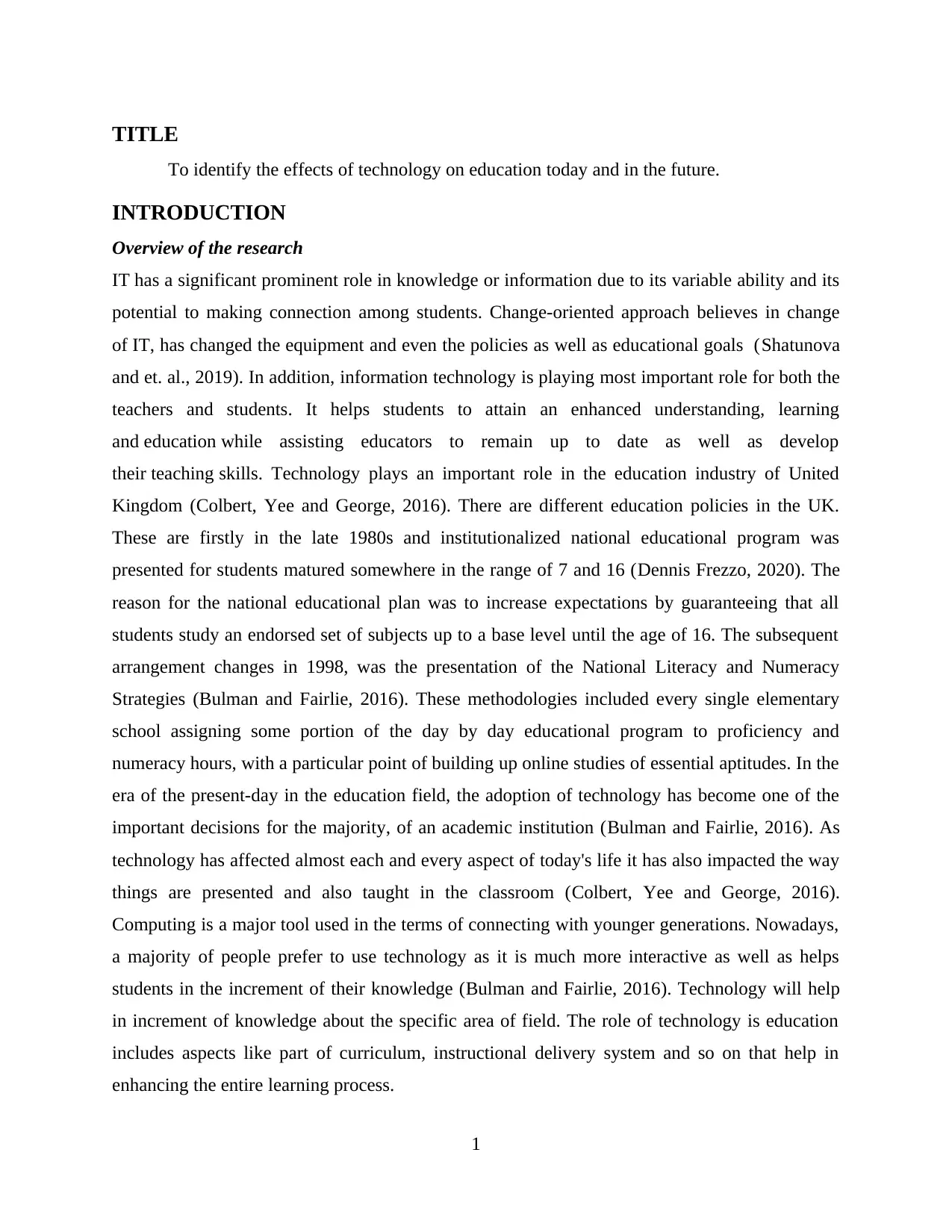
TITLE
To identify the effects of technology on education today and in the future.
INTRODUCTION
Overview of the research
IT has a significant prominent role in knowledge or information due to its variable ability and its
potential to making connection among students. Change-oriented approach believes in change
of IT, has changed the equipment and even the policies as well as educational goals (Shatunova
and et. al., 2019). In addition, information technology is playing most important role for both the
teachers and students. It helps students to attain an enhanced understanding, learning
and education while assisting educators to remain up to date as well as develop
their teaching skills. Technology plays an important role in the education industry of United
Kingdom (Colbert, Yee and George, 2016). There are different education policies in the UK.
These are firstly in the late 1980s and institutionalized national educational program was
presented for students matured somewhere in the range of 7 and 16 (Dennis Frezzo, 2020). The
reason for the national educational plan was to increase expectations by guaranteeing that all
students study an endorsed set of subjects up to a base level until the age of 16. The subsequent
arrangement changes in 1998, was the presentation of the National Literacy and Numeracy
Strategies (Bulman and Fairlie, 2016). These methodologies included every single elementary
school assigning some portion of the day by day educational program to proficiency and
numeracy hours, with a particular point of building up online studies of essential aptitudes. In the
era of the present-day in the education field, the adoption of technology has become one of the
important decisions for the majority, of an academic institution (Bulman and Fairlie, 2016). As
technology has affected almost each and every aspect of today's life it has also impacted the way
things are presented and also taught in the classroom (Colbert, Yee and George, 2016).
Computing is a major tool used in the terms of connecting with younger generations. Nowadays,
a majority of people prefer to use technology as it is much more interactive as well as helps
students in the increment of their knowledge (Bulman and Fairlie, 2016). Technology will help
in increment of knowledge about the specific area of field. The role of technology is education
includes aspects like part of curriculum, instructional delivery system and so on that help in
enhancing the entire learning process.
1
To identify the effects of technology on education today and in the future.
INTRODUCTION
Overview of the research
IT has a significant prominent role in knowledge or information due to its variable ability and its
potential to making connection among students. Change-oriented approach believes in change
of IT, has changed the equipment and even the policies as well as educational goals (Shatunova
and et. al., 2019). In addition, information technology is playing most important role for both the
teachers and students. It helps students to attain an enhanced understanding, learning
and education while assisting educators to remain up to date as well as develop
their teaching skills. Technology plays an important role in the education industry of United
Kingdom (Colbert, Yee and George, 2016). There are different education policies in the UK.
These are firstly in the late 1980s and institutionalized national educational program was
presented for students matured somewhere in the range of 7 and 16 (Dennis Frezzo, 2020). The
reason for the national educational plan was to increase expectations by guaranteeing that all
students study an endorsed set of subjects up to a base level until the age of 16. The subsequent
arrangement changes in 1998, was the presentation of the National Literacy and Numeracy
Strategies (Bulman and Fairlie, 2016). These methodologies included every single elementary
school assigning some portion of the day by day educational program to proficiency and
numeracy hours, with a particular point of building up online studies of essential aptitudes. In the
era of the present-day in the education field, the adoption of technology has become one of the
important decisions for the majority, of an academic institution (Bulman and Fairlie, 2016). As
technology has affected almost each and every aspect of today's life it has also impacted the way
things are presented and also taught in the classroom (Colbert, Yee and George, 2016).
Computing is a major tool used in the terms of connecting with younger generations. Nowadays,
a majority of people prefer to use technology as it is much more interactive as well as helps
students in the increment of their knowledge (Bulman and Fairlie, 2016). Technology will help
in increment of knowledge about the specific area of field. The role of technology is education
includes aspects like part of curriculum, instructional delivery system and so on that help in
enhancing the entire learning process.
1
Paraphrase This Document
Need a fresh take? Get an instant paraphrase of this document with our AI Paraphraser
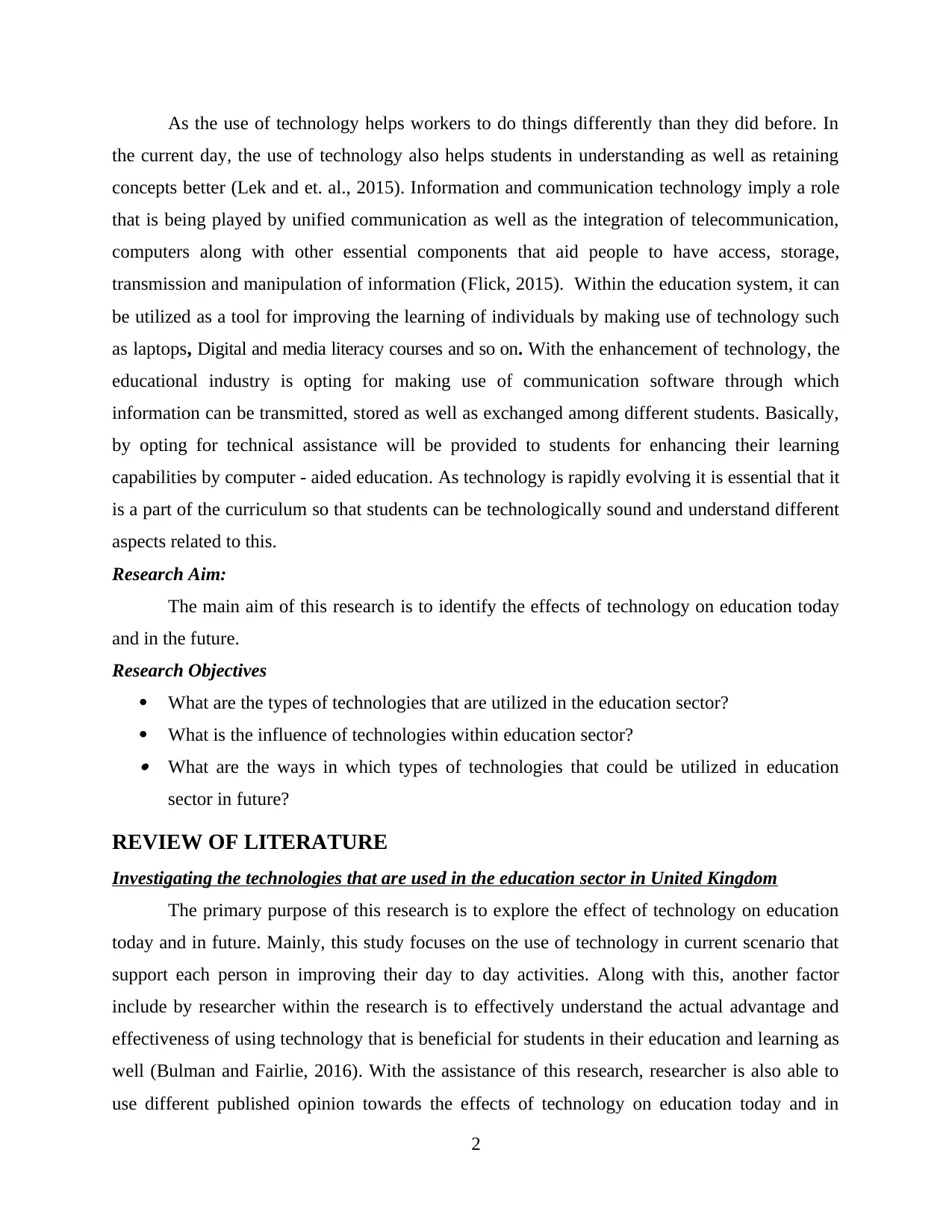
As the use of technology helps workers to do things differently than they did before. In
the current day, the use of technology also helps students in understanding as well as retaining
concepts better (Lek and et. al., 2015). Information and communication technology imply a role
that is being played by unified communication as well as the integration of telecommunication,
computers along with other essential components that aid people to have access, storage,
transmission and manipulation of information (Flick, 2015). Within the education system, it can
be utilized as a tool for improving the learning of individuals by making use of technology such
as laptops, Digital and media literacy courses and so on. With the enhancement of technology, the
educational industry is opting for making use of communication software through which
information can be transmitted, stored as well as exchanged among different students. Basically,
by opting for technical assistance will be provided to students for enhancing their learning
capabilities by computer - aided education. As technology is rapidly evolving it is essential that it
is a part of the curriculum so that students can be technologically sound and understand different
aspects related to this.
Research Aim:
The main aim of this research is to identify the effects of technology on education today
and in the future.
Research Objectives
What are the types of technologies that are utilized in the education sector?
What is the influence of technologies within education sector? What are the ways in which types of technologies that could be utilized in education
sector in future?
REVIEW OF LITERATURE
Investigating the technologies that are used in the education sector in United Kingdom
The primary purpose of this research is to explore the effect of technology on education
today and in future. Mainly, this study focuses on the use of technology in current scenario that
support each person in improving their day to day activities. Along with this, another factor
include by researcher within the research is to effectively understand the actual advantage and
effectiveness of using technology that is beneficial for students in their education and learning as
well (Bulman and Fairlie, 2016). With the assistance of this research, researcher is also able to
use different published opinion towards the effects of technology on education today and in
2
the current day, the use of technology also helps students in understanding as well as retaining
concepts better (Lek and et. al., 2015). Information and communication technology imply a role
that is being played by unified communication as well as the integration of telecommunication,
computers along with other essential components that aid people to have access, storage,
transmission and manipulation of information (Flick, 2015). Within the education system, it can
be utilized as a tool for improving the learning of individuals by making use of technology such
as laptops, Digital and media literacy courses and so on. With the enhancement of technology, the
educational industry is opting for making use of communication software through which
information can be transmitted, stored as well as exchanged among different students. Basically,
by opting for technical assistance will be provided to students for enhancing their learning
capabilities by computer - aided education. As technology is rapidly evolving it is essential that it
is a part of the curriculum so that students can be technologically sound and understand different
aspects related to this.
Research Aim:
The main aim of this research is to identify the effects of technology on education today
and in the future.
Research Objectives
What are the types of technologies that are utilized in the education sector?
What is the influence of technologies within education sector? What are the ways in which types of technologies that could be utilized in education
sector in future?
REVIEW OF LITERATURE
Investigating the technologies that are used in the education sector in United Kingdom
The primary purpose of this research is to explore the effect of technology on education
today and in future. Mainly, this study focuses on the use of technology in current scenario that
support each person in improving their day to day activities. Along with this, another factor
include by researcher within the research is to effectively understand the actual advantage and
effectiveness of using technology that is beneficial for students in their education and learning as
well (Bulman and Fairlie, 2016). With the assistance of this research, researcher is also able to
use different published opinion towards the effects of technology on education today and in
2
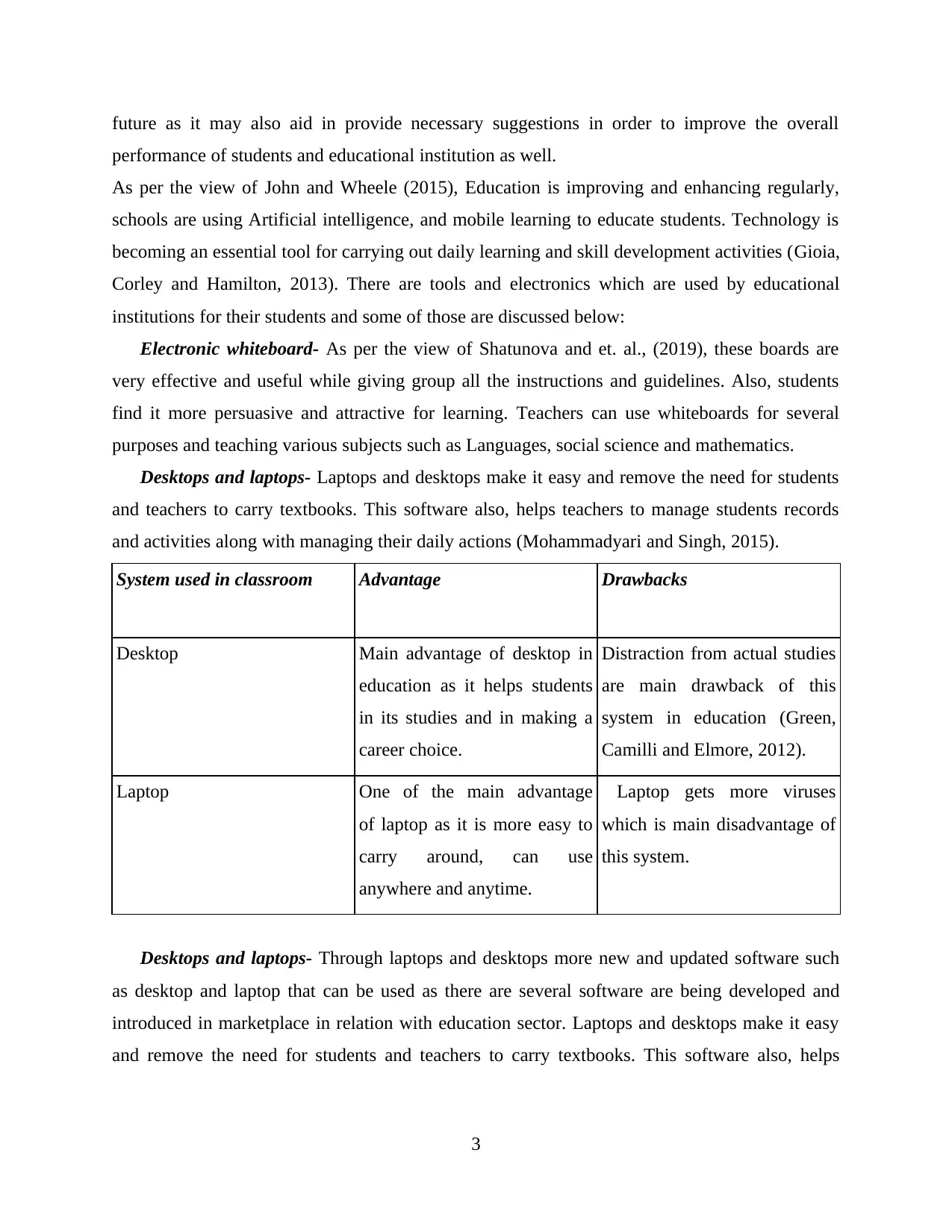
future as it may also aid in provide necessary suggestions in order to improve the overall
performance of students and educational institution as well.
As per the view of John and Wheele (2015), Education is improving and enhancing regularly,
schools are using Artificial intelligence, and mobile learning to educate students. Technology is
becoming an essential tool for carrying out daily learning and skill development activities (Gioia,
Corley and Hamilton, 2013). There are tools and electronics which are used by educational
institutions for their students and some of those are discussed below:
Electronic whiteboard- As per the view of Shatunova and et. al., (2019), these boards are
very effective and useful while giving group all the instructions and guidelines. Also, students
find it more persuasive and attractive for learning. Teachers can use whiteboards for several
purposes and teaching various subjects such as Languages, social science and mathematics.
Desktops and laptops- Laptops and desktops make it easy and remove the need for students
and teachers to carry textbooks. This software also, helps teachers to manage students records
and activities along with managing their daily actions (Mohammadyari and Singh, 2015).
System used in classroom Advantage Drawbacks
Desktop Main advantage of desktop in
education as it helps students
in its studies and in making a
career choice.
Distraction from actual studies
are main drawback of this
system in education (Green,
Camilli and Elmore, 2012).
Laptop One of the main advantage
of laptop as it is more easy to
carry around, can use
anywhere and anytime.
Laptop gets more viruses
which is main disadvantage of
this system.
Desktops and laptops- Through laptops and desktops more new and updated software such
as desktop and laptop that can be used as there are several software are being developed and
introduced in marketplace in relation with education sector. Laptops and desktops make it easy
and remove the need for students and teachers to carry textbooks. This software also, helps
3
performance of students and educational institution as well.
As per the view of John and Wheele (2015), Education is improving and enhancing regularly,
schools are using Artificial intelligence, and mobile learning to educate students. Technology is
becoming an essential tool for carrying out daily learning and skill development activities (Gioia,
Corley and Hamilton, 2013). There are tools and electronics which are used by educational
institutions for their students and some of those are discussed below:
Electronic whiteboard- As per the view of Shatunova and et. al., (2019), these boards are
very effective and useful while giving group all the instructions and guidelines. Also, students
find it more persuasive and attractive for learning. Teachers can use whiteboards for several
purposes and teaching various subjects such as Languages, social science and mathematics.
Desktops and laptops- Laptops and desktops make it easy and remove the need for students
and teachers to carry textbooks. This software also, helps teachers to manage students records
and activities along with managing their daily actions (Mohammadyari and Singh, 2015).
System used in classroom Advantage Drawbacks
Desktop Main advantage of desktop in
education as it helps students
in its studies and in making a
career choice.
Distraction from actual studies
are main drawback of this
system in education (Green,
Camilli and Elmore, 2012).
Laptop One of the main advantage
of laptop as it is more easy to
carry around, can use
anywhere and anytime.
Laptop gets more viruses
which is main disadvantage of
this system.
Desktops and laptops- Through laptops and desktops more new and updated software such
as desktop and laptop that can be used as there are several software are being developed and
introduced in marketplace in relation with education sector. Laptops and desktops make it easy
and remove the need for students and teachers to carry textbooks. This software also, helps
3
⊘ This is a preview!⊘
Do you want full access?
Subscribe today to unlock all pages.

Trusted by 1+ million students worldwide
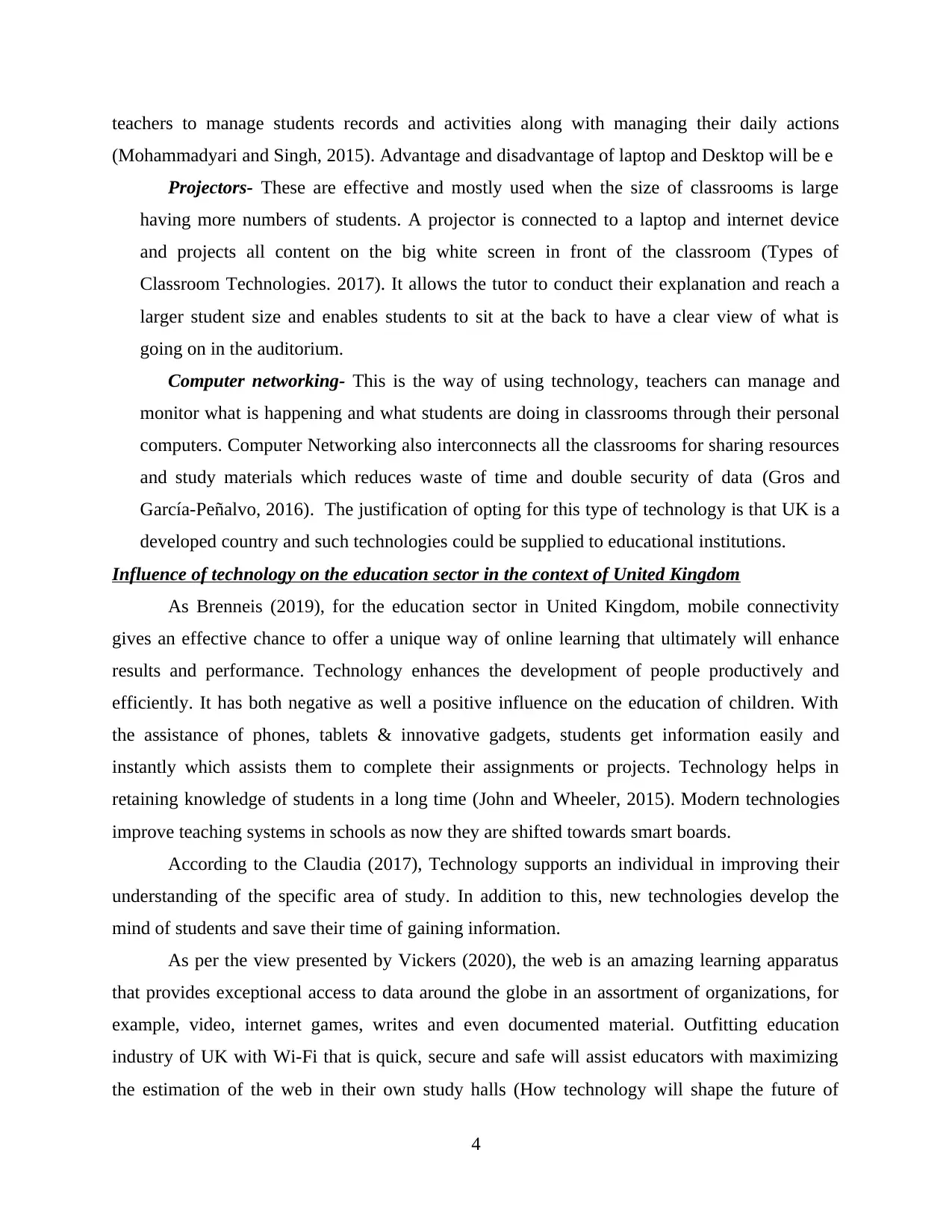
teachers to manage students records and activities along with managing their daily actions
(Mohammadyari and Singh, 2015). Advantage and disadvantage of laptop and Desktop will be e
Projectors- These are effective and mostly used when the size of classrooms is large
having more numbers of students. A projector is connected to a laptop and internet device
and projects all content on the big white screen in front of the classroom (Types of
Classroom Technologies. 2017). It allows the tutor to conduct their explanation and reach a
larger student size and enables students to sit at the back to have a clear view of what is
going on in the auditorium.
Computer networking- This is the way of using technology, teachers can manage and
monitor what is happening and what students are doing in classrooms through their personal
computers. Computer Networking also interconnects all the classrooms for sharing resources
and study materials which reduces waste of time and double security of data (Gros and
García-Peñalvo, 2016). The justification of opting for this type of technology is that UK is a
developed country and such technologies could be supplied to educational institutions.
Influence of technology on the education sector in the context of United Kingdom
As Brenneis (2019), for the education sector in United Kingdom, mobile connectivity
gives an effective chance to offer a unique way of online learning that ultimately will enhance
results and performance. Technology enhances the development of people productively and
efficiently. It has both negative as well a positive influence on the education of children. With
the assistance of phones, tablets & innovative gadgets, students get information easily and
instantly which assists them to complete their assignments or projects. Technology helps in
retaining knowledge of students in a long time (John and Wheeler, 2015). Modern technologies
improve teaching systems in schools as now they are shifted towards smart boards.
According to the Claudia (2017), Technology supports an individual in improving their
understanding of the specific area of study. In addition to this, new technologies develop the
mind of students and save their time of gaining information.
As per the view presented by Vickers (2020), the web is an amazing learning apparatus
that provides exceptional access to data around the globe in an assortment of organizations, for
example, video, internet games, writes and even documented material. Outfitting education
industry of UK with Wi-Fi that is quick, secure and safe will assist educators with maximizing
the estimation of the web in their own study halls (How technology will shape the future of
4
(Mohammadyari and Singh, 2015). Advantage and disadvantage of laptop and Desktop will be e
Projectors- These are effective and mostly used when the size of classrooms is large
having more numbers of students. A projector is connected to a laptop and internet device
and projects all content on the big white screen in front of the classroom (Types of
Classroom Technologies. 2017). It allows the tutor to conduct their explanation and reach a
larger student size and enables students to sit at the back to have a clear view of what is
going on in the auditorium.
Computer networking- This is the way of using technology, teachers can manage and
monitor what is happening and what students are doing in classrooms through their personal
computers. Computer Networking also interconnects all the classrooms for sharing resources
and study materials which reduces waste of time and double security of data (Gros and
García-Peñalvo, 2016). The justification of opting for this type of technology is that UK is a
developed country and such technologies could be supplied to educational institutions.
Influence of technology on the education sector in the context of United Kingdom
As Brenneis (2019), for the education sector in United Kingdom, mobile connectivity
gives an effective chance to offer a unique way of online learning that ultimately will enhance
results and performance. Technology enhances the development of people productively and
efficiently. It has both negative as well a positive influence on the education of children. With
the assistance of phones, tablets & innovative gadgets, students get information easily and
instantly which assists them to complete their assignments or projects. Technology helps in
retaining knowledge of students in a long time (John and Wheeler, 2015). Modern technologies
improve teaching systems in schools as now they are shifted towards smart boards.
According to the Claudia (2017), Technology supports an individual in improving their
understanding of the specific area of study. In addition to this, new technologies develop the
mind of students and save their time of gaining information.
As per the view presented by Vickers (2020), the web is an amazing learning apparatus
that provides exceptional access to data around the globe in an assortment of organizations, for
example, video, internet games, writes and even documented material. Outfitting education
industry of UK with Wi-Fi that is quick, secure and safe will assist educators with maximizing
the estimation of the web in their own study halls (How technology will shape the future of
4
Paraphrase This Document
Need a fresh take? Get an instant paraphrase of this document with our AI Paraphraser
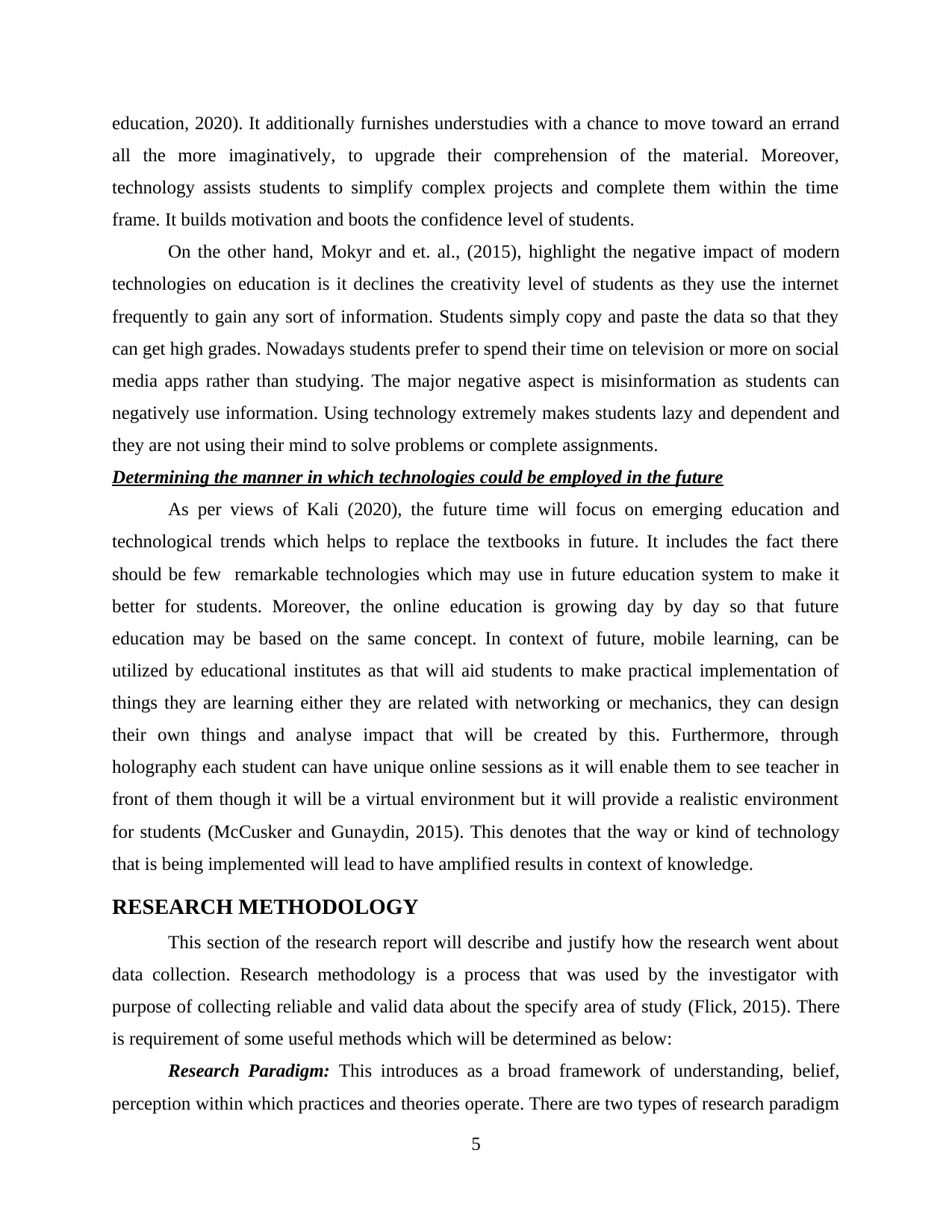
education, 2020). It additionally furnishes understudies with a chance to move toward an errand
all the more imaginatively, to upgrade their comprehension of the material. Moreover,
technology assists students to simplify complex projects and complete them within the time
frame. It builds motivation and boots the confidence level of students.
On the other hand, Mokyr and et. al., (2015), highlight the negative impact of modern
technologies on education is it declines the creativity level of students as they use the internet
frequently to gain any sort of information. Students simply copy and paste the data so that they
can get high grades. Nowadays students prefer to spend their time on television or more on social
media apps rather than studying. The major negative aspect is misinformation as students can
negatively use information. Using technology extremely makes students lazy and dependent and
they are not using their mind to solve problems or complete assignments.
Determining the manner in which technologies could be employed in the future
As per views of Kali (2020), the future time will focus on emerging education and
technological trends which helps to replace the textbooks in future. It includes the fact there
should be few remarkable technologies which may use in future education system to make it
better for students. Moreover, the online education is growing day by day so that future
education may be based on the same concept. In context of future, mobile learning, can be
utilized by educational institutes as that will aid students to make practical implementation of
things they are learning either they are related with networking or mechanics, they can design
their own things and analyse impact that will be created by this. Furthermore, through
holography each student can have unique online sessions as it will enable them to see teacher in
front of them though it will be a virtual environment but it will provide a realistic environment
for students (McCusker and Gunaydin, 2015). This denotes that the way or kind of technology
that is being implemented will lead to have amplified results in context of knowledge.
RESEARCH METHODOLOGY
This section of the research report will describe and justify how the research went about
data collection. Research methodology is a process that was used by the investigator with
purpose of collecting reliable and valid data about the specify area of study (Flick, 2015). There
is requirement of some useful methods which will be determined as below:
Research Paradigm: This introduces as a broad framework of understanding, belief,
perception within which practices and theories operate. There are two types of research paradigm
5
all the more imaginatively, to upgrade their comprehension of the material. Moreover,
technology assists students to simplify complex projects and complete them within the time
frame. It builds motivation and boots the confidence level of students.
On the other hand, Mokyr and et. al., (2015), highlight the negative impact of modern
technologies on education is it declines the creativity level of students as they use the internet
frequently to gain any sort of information. Students simply copy and paste the data so that they
can get high grades. Nowadays students prefer to spend their time on television or more on social
media apps rather than studying. The major negative aspect is misinformation as students can
negatively use information. Using technology extremely makes students lazy and dependent and
they are not using their mind to solve problems or complete assignments.
Determining the manner in which technologies could be employed in the future
As per views of Kali (2020), the future time will focus on emerging education and
technological trends which helps to replace the textbooks in future. It includes the fact there
should be few remarkable technologies which may use in future education system to make it
better for students. Moreover, the online education is growing day by day so that future
education may be based on the same concept. In context of future, mobile learning, can be
utilized by educational institutes as that will aid students to make practical implementation of
things they are learning either they are related with networking or mechanics, they can design
their own things and analyse impact that will be created by this. Furthermore, through
holography each student can have unique online sessions as it will enable them to see teacher in
front of them though it will be a virtual environment but it will provide a realistic environment
for students (McCusker and Gunaydin, 2015). This denotes that the way or kind of technology
that is being implemented will lead to have amplified results in context of knowledge.
RESEARCH METHODOLOGY
This section of the research report will describe and justify how the research went about
data collection. Research methodology is a process that was used by the investigator with
purpose of collecting reliable and valid data about the specify area of study (Flick, 2015). There
is requirement of some useful methods which will be determined as below:
Research Paradigm: This introduces as a broad framework of understanding, belief,
perception within which practices and theories operate. There are two types of research paradigm
5
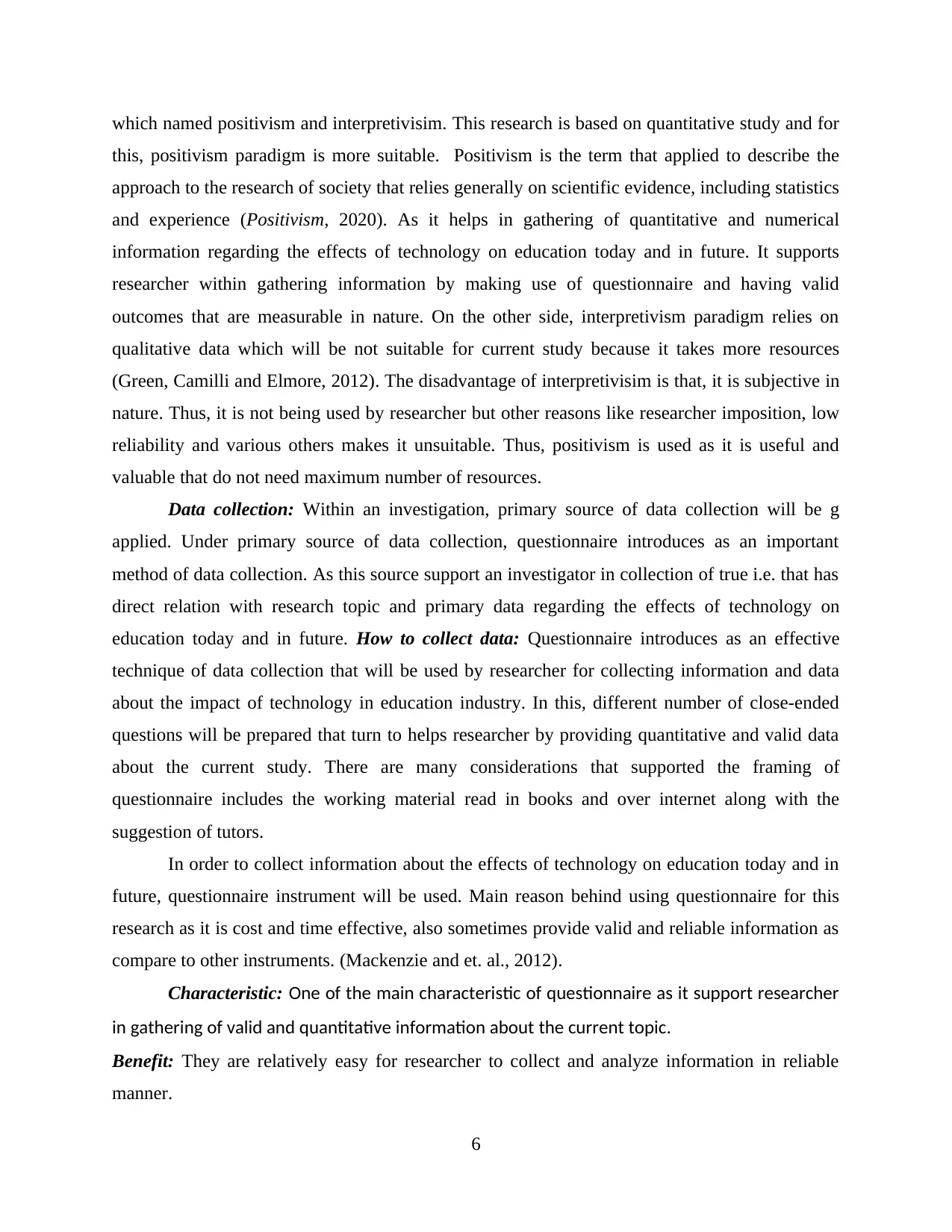
which named positivism and interpretivisim. This research is based on quantitative study and for
this, positivism paradigm is more suitable. Positivism is the term that applied to describe the
approach to the research of society that relies generally on scientific evidence, including statistics
and experience (Positivism, 2020). As it helps in gathering of quantitative and numerical
information regarding the effects of technology on education today and in future. It supports
researcher within gathering information by making use of questionnaire and having valid
outcomes that are measurable in nature. On the other side, interpretivism paradigm relies on
qualitative data which will be not suitable for current study because it takes more resources
(Green, Camilli and Elmore, 2012). The disadvantage of interpretivisim is that, it is subjective in
nature. Thus, it is not being used by researcher but other reasons like researcher imposition, low
reliability and various others makes it unsuitable. Thus, positivism is used as it is useful and
valuable that do not need maximum number of resources.
Data collection: Within an investigation, primary source of data collection will be g
applied. Under primary source of data collection, questionnaire introduces as an important
method of data collection. As this source support an investigator in collection of true i.e. that has
direct relation with research topic and primary data regarding the effects of technology on
education today and in future. How to collect data: Questionnaire introduces as an effective
technique of data collection that will be used by researcher for collecting information and data
about the impact of technology in education industry. In this, different number of close-ended
questions will be prepared that turn to helps researcher by providing quantitative and valid data
about the current study. There are many considerations that supported the framing of
questionnaire includes the working material read in books and over internet along with the
suggestion of tutors.
In order to collect information about the effects of technology on education today and in
future, questionnaire instrument will be used. Main reason behind using questionnaire for this
research as it is cost and time effective, also sometimes provide valid and reliable information as
compare to other instruments. (Mackenzie and et. al., 2012).
Characteristic: One of the main characteristic of questionnaire as it support researcher
in gathering of valid and quantitative information about the current topic.
Benefit: They are relatively easy for researcher to collect and analyze information in reliable
manner.
6
this, positivism paradigm is more suitable. Positivism is the term that applied to describe the
approach to the research of society that relies generally on scientific evidence, including statistics
and experience (Positivism, 2020). As it helps in gathering of quantitative and numerical
information regarding the effects of technology on education today and in future. It supports
researcher within gathering information by making use of questionnaire and having valid
outcomes that are measurable in nature. On the other side, interpretivism paradigm relies on
qualitative data which will be not suitable for current study because it takes more resources
(Green, Camilli and Elmore, 2012). The disadvantage of interpretivisim is that, it is subjective in
nature. Thus, it is not being used by researcher but other reasons like researcher imposition, low
reliability and various others makes it unsuitable. Thus, positivism is used as it is useful and
valuable that do not need maximum number of resources.
Data collection: Within an investigation, primary source of data collection will be g
applied. Under primary source of data collection, questionnaire introduces as an important
method of data collection. As this source support an investigator in collection of true i.e. that has
direct relation with research topic and primary data regarding the effects of technology on
education today and in future. How to collect data: Questionnaire introduces as an effective
technique of data collection that will be used by researcher for collecting information and data
about the impact of technology in education industry. In this, different number of close-ended
questions will be prepared that turn to helps researcher by providing quantitative and valid data
about the current study. There are many considerations that supported the framing of
questionnaire includes the working material read in books and over internet along with the
suggestion of tutors.
In order to collect information about the effects of technology on education today and in
future, questionnaire instrument will be used. Main reason behind using questionnaire for this
research as it is cost and time effective, also sometimes provide valid and reliable information as
compare to other instruments. (Mackenzie and et. al., 2012).
Characteristic: One of the main characteristic of questionnaire as it support researcher
in gathering of valid and quantitative information about the current topic.
Benefit: They are relatively easy for researcher to collect and analyze information in reliable
manner.
6
⊘ This is a preview!⊘
Do you want full access?
Subscribe today to unlock all pages.

Trusted by 1+ million students worldwide
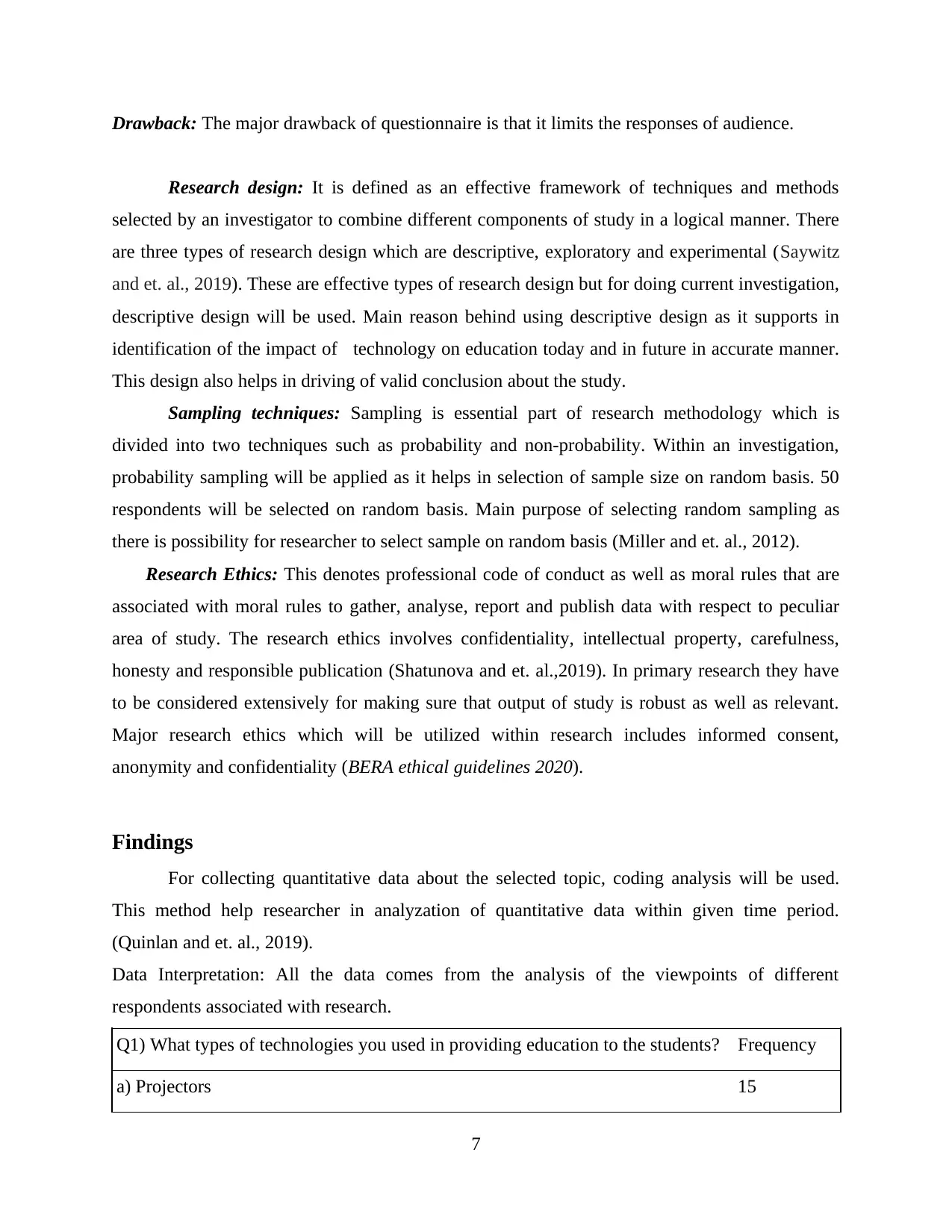
Drawback: The major drawback of questionnaire is that it limits the responses of audience.
Research design: It is defined as an effective framework of techniques and methods
selected by an investigator to combine different components of study in a logical manner. There
are three types of research design which are descriptive, exploratory and experimental (Saywitz
and et. al., 2019). These are effective types of research design but for doing current investigation,
descriptive design will be used. Main reason behind using descriptive design as it supports in
identification of the impact of technology on education today and in future in accurate manner.
This design also helps in driving of valid conclusion about the study.
Sampling techniques: Sampling is essential part of research methodology which is
divided into two techniques such as probability and non-probability. Within an investigation,
probability sampling will be applied as it helps in selection of sample size on random basis. 50
respondents will be selected on random basis. Main purpose of selecting random sampling as
there is possibility for researcher to select sample on random basis (Miller and et. al., 2012).
Research Ethics: This denotes professional code of conduct as well as moral rules that are
associated with moral rules to gather, analyse, report and publish data with respect to peculiar
area of study. The research ethics involves confidentiality, intellectual property, carefulness,
honesty and responsible publication (Shatunova and et. al.,2019). In primary research they have
to be considered extensively for making sure that output of study is robust as well as relevant.
Major research ethics which will be utilized within research includes informed consent,
anonymity and confidentiality (BERA ethical guidelines 2020).
Findings
For collecting quantitative data about the selected topic, coding analysis will be used.
This method help researcher in analyzation of quantitative data within given time period.
(Quinlan and et. al., 2019).
Data Interpretation: All the data comes from the analysis of the viewpoints of different
respondents associated with research.
Q1) What types of technologies you used in providing education to the students? Frequency
a) Projectors 15
7
Research design: It is defined as an effective framework of techniques and methods
selected by an investigator to combine different components of study in a logical manner. There
are three types of research design which are descriptive, exploratory and experimental (Saywitz
and et. al., 2019). These are effective types of research design but for doing current investigation,
descriptive design will be used. Main reason behind using descriptive design as it supports in
identification of the impact of technology on education today and in future in accurate manner.
This design also helps in driving of valid conclusion about the study.
Sampling techniques: Sampling is essential part of research methodology which is
divided into two techniques such as probability and non-probability. Within an investigation,
probability sampling will be applied as it helps in selection of sample size on random basis. 50
respondents will be selected on random basis. Main purpose of selecting random sampling as
there is possibility for researcher to select sample on random basis (Miller and et. al., 2012).
Research Ethics: This denotes professional code of conduct as well as moral rules that are
associated with moral rules to gather, analyse, report and publish data with respect to peculiar
area of study. The research ethics involves confidentiality, intellectual property, carefulness,
honesty and responsible publication (Shatunova and et. al.,2019). In primary research they have
to be considered extensively for making sure that output of study is robust as well as relevant.
Major research ethics which will be utilized within research includes informed consent,
anonymity and confidentiality (BERA ethical guidelines 2020).
Findings
For collecting quantitative data about the selected topic, coding analysis will be used.
This method help researcher in analyzation of quantitative data within given time period.
(Quinlan and et. al., 2019).
Data Interpretation: All the data comes from the analysis of the viewpoints of different
respondents associated with research.
Q1) What types of technologies you used in providing education to the students? Frequency
a) Projectors 15
7
Paraphrase This Document
Need a fresh take? Get an instant paraphrase of this document with our AI Paraphraser
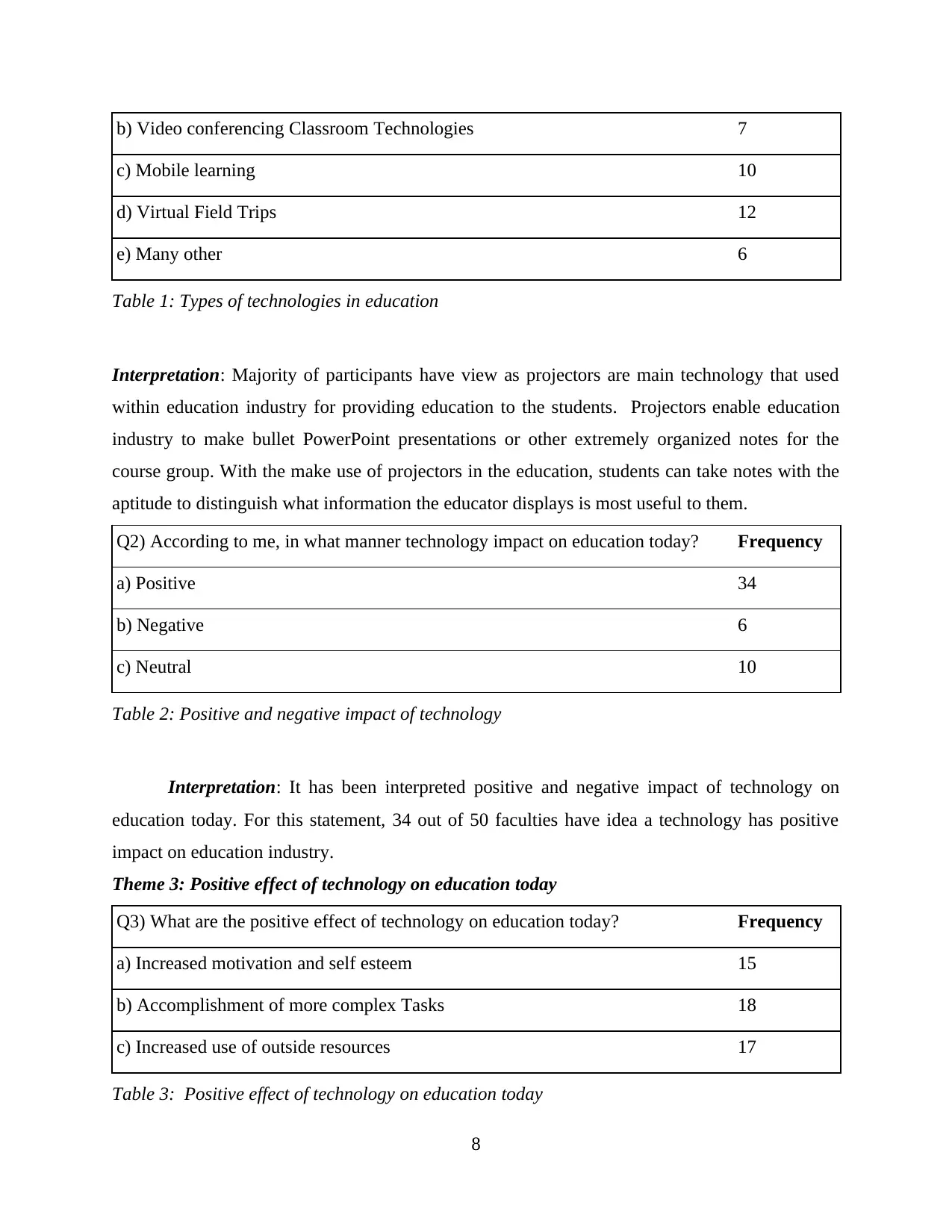
b) Video conferencing Classroom Technologies 7
c) Mobile learning 10
d) Virtual Field Trips 12
e) Many other 6
Table 1: Types of technologies in education
Interpretation: Majority of participants have view as projectors are main technology that used
within education industry for providing education to the students. Projectors enable education
industry to make bullet PowerPoint presentations or other extremely organized notes for the
course group. With the make use of projectors in the education, students can take notes with the
aptitude to distinguish what information the educator displays is most useful to them.
Q2) According to me, in what manner technology impact on education today? Frequency
a) Positive 34
b) Negative 6
c) Neutral 10
Table 2: Positive and negative impact of technology
Interpretation: It has been interpreted positive and negative impact of technology on
education today. For this statement, 34 out of 50 faculties have idea a technology has positive
impact on education industry.
Theme 3: Positive effect of technology on education today
Q3) What are the positive effect of technology on education today? Frequency
a) Increased motivation and self esteem 15
b) Accomplishment of more complex Tasks 18
c) Increased use of outside resources 17
Table 3: Positive effect of technology on education today
8
c) Mobile learning 10
d) Virtual Field Trips 12
e) Many other 6
Table 1: Types of technologies in education
Interpretation: Majority of participants have view as projectors are main technology that used
within education industry for providing education to the students. Projectors enable education
industry to make bullet PowerPoint presentations or other extremely organized notes for the
course group. With the make use of projectors in the education, students can take notes with the
aptitude to distinguish what information the educator displays is most useful to them.
Q2) According to me, in what manner technology impact on education today? Frequency
a) Positive 34
b) Negative 6
c) Neutral 10
Table 2: Positive and negative impact of technology
Interpretation: It has been interpreted positive and negative impact of technology on
education today. For this statement, 34 out of 50 faculties have idea a technology has positive
impact on education industry.
Theme 3: Positive effect of technology on education today
Q3) What are the positive effect of technology on education today? Frequency
a) Increased motivation and self esteem 15
b) Accomplishment of more complex Tasks 18
c) Increased use of outside resources 17
Table 3: Positive effect of technology on education today
8
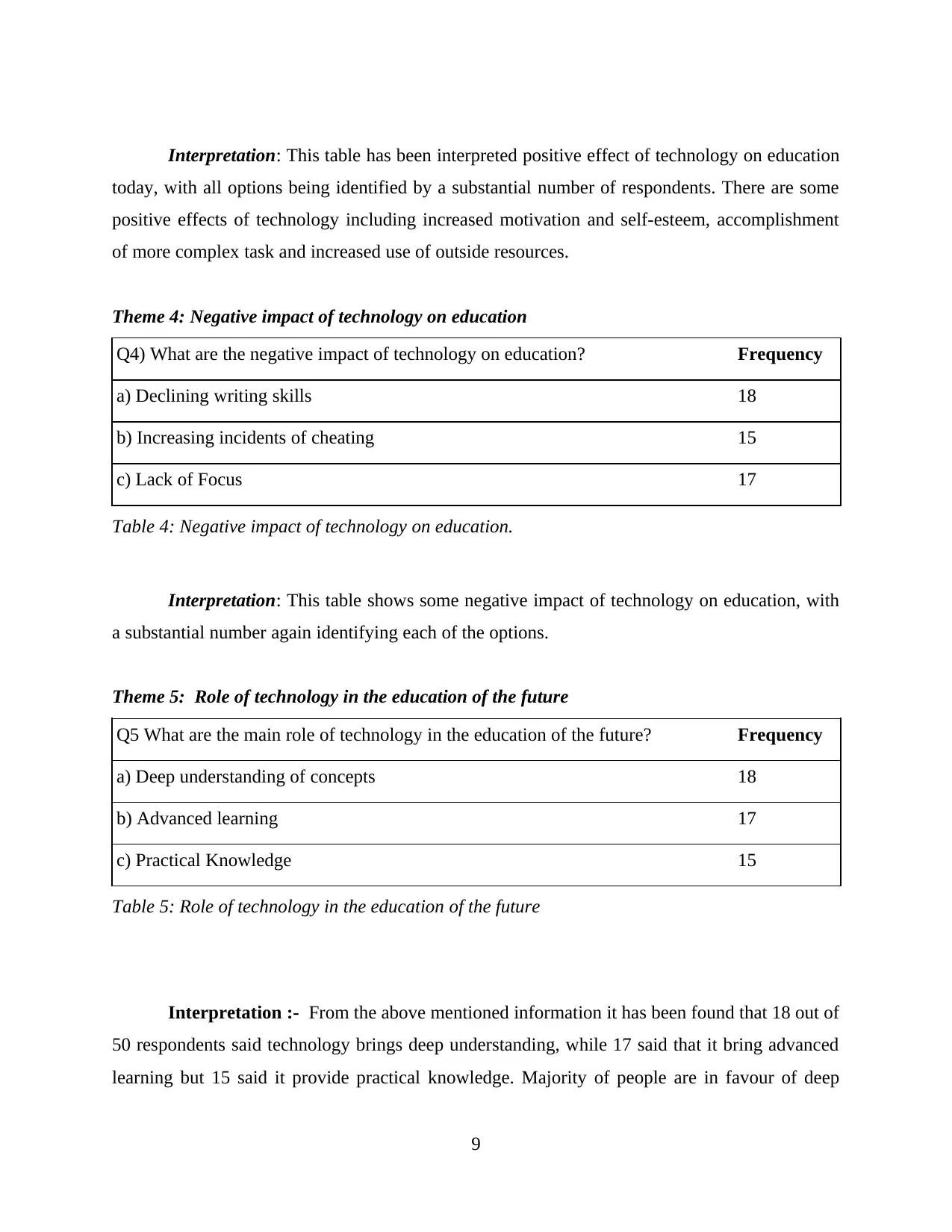
Interpretation: This table has been interpreted positive effect of technology on education
today, with all options being identified by a substantial number of respondents. There are some
positive effects of technology including increased motivation and self-esteem, accomplishment
of more complex task and increased use of outside resources.
Theme 4: Negative impact of technology on education
Q4) What are the negative impact of technology on education? Frequency
a) Declining writing skills 18
b) Increasing incidents of cheating 15
c) Lack of Focus 17
Table 4: Negative impact of technology on education.
Interpretation: This table shows some negative impact of technology on education, with
a substantial number again identifying each of the options.
Theme 5: Role of technology in the education of the future
Q5 What are the main role of technology in the education of the future? Frequency
a) Deep understanding of concepts 18
b) Advanced learning 17
c) Practical Knowledge 15
Table 5: Role of technology in the education of the future
Interpretation :- From the above mentioned information it has been found that 18 out of
50 respondents said technology brings deep understanding, while 17 said that it bring advanced
learning but 15 said it provide practical knowledge. Majority of people are in favour of deep
9
today, with all options being identified by a substantial number of respondents. There are some
positive effects of technology including increased motivation and self-esteem, accomplishment
of more complex task and increased use of outside resources.
Theme 4: Negative impact of technology on education
Q4) What are the negative impact of technology on education? Frequency
a) Declining writing skills 18
b) Increasing incidents of cheating 15
c) Lack of Focus 17
Table 4: Negative impact of technology on education.
Interpretation: This table shows some negative impact of technology on education, with
a substantial number again identifying each of the options.
Theme 5: Role of technology in the education of the future
Q5 What are the main role of technology in the education of the future? Frequency
a) Deep understanding of concepts 18
b) Advanced learning 17
c) Practical Knowledge 15
Table 5: Role of technology in the education of the future
Interpretation :- From the above mentioned information it has been found that 18 out of
50 respondents said technology brings deep understanding, while 17 said that it bring advanced
learning but 15 said it provide practical knowledge. Majority of people are in favour of deep
9
⊘ This is a preview!⊘
Do you want full access?
Subscribe today to unlock all pages.

Trusted by 1+ million students worldwide
1 out of 25
Related Documents
Your All-in-One AI-Powered Toolkit for Academic Success.
+13062052269
info@desklib.com
Available 24*7 on WhatsApp / Email
![[object Object]](/_next/static/media/star-bottom.7253800d.svg)
Unlock your academic potential
Copyright © 2020–2025 A2Z Services. All Rights Reserved. Developed and managed by ZUCOL.

![Alibaba Group Sustainability Analysis Essay: Course [Code/Name]](/_next/image/?url=https%3A%2F%2Fdesklib.com%2Fmedia%2Fimages%2Fmc%2F58520fa985f64d6aa1043ba966a5eb03.jpg&w=256&q=75)



